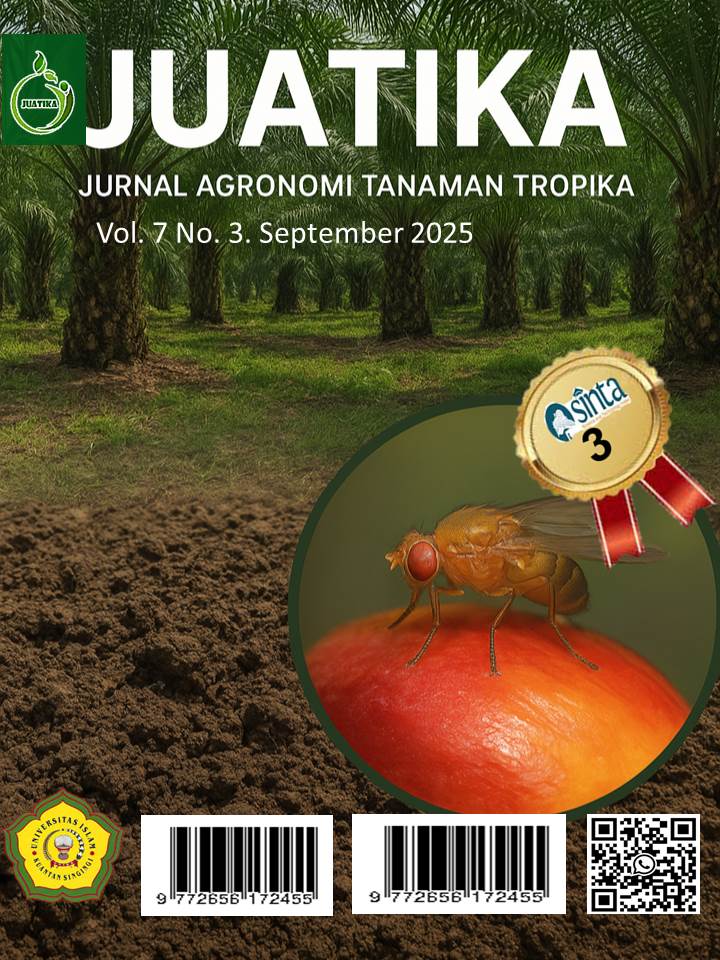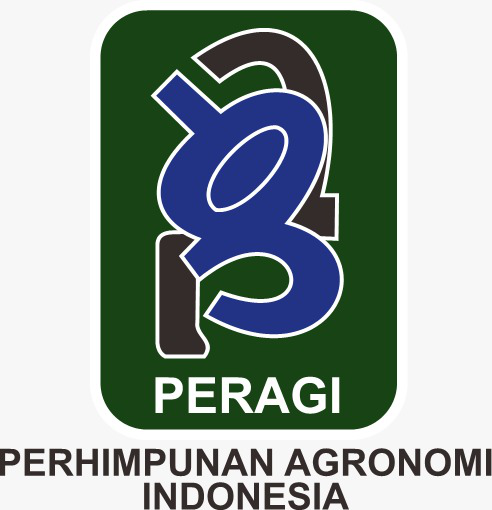Optimization of Biological Nitrogen Fixation by Rhizobium Bacteria to Enhance Growth and Yield of Soybean (Glycine max L.)
Abstract
Rhizobium bacteria play a pivotal role in soybean (Glycine max L.) cultivation through their ability to perform biological nitrogen fixation. The effectiveness of Rhizobium in increasing crop yield is influenced by the soybean variety and the inoculation dose applied. Therefore, the application of Rhizobium inoculants appropriate to soybean varieties has the potential to increase the efficiency of nitrogen utilization in a sustainable and environmentally friendly manner. This study aims to determine the effectiveness of Rhizobium strain doses on the growth and production of two soybean varieties. The study was conducted using a factorial Randomized Block Design (RBD), consisting of two factors: soybean varieties (Anjasmoro and Dega 1) and Rhizobium doses (control/without Rhizobium, 10 g/kg seed, and 15 g/kg seed). Data were analyzed using analysis of variance (ANOVA) and continued with Duncan’s Multiple Range Test (DMRT) at a significance level of 5%. The results showed that the interaction between soybean varieties and Rhizobium doses had a significant effect on leaf area. The best treatment combination was obtained with the Dega 1 variety and a Rhizobium dose of 15 g/kg of seeds. The Dega 1 variety had a significant effect on seed weight per plant and per plot. This variety demonstrates superior physiological capabilities and adaptability in utilizing growing resources for seed biomass accumulation, thereby contributing to increased national soybean yields. A Rhizobium dose of 15 g/kg seed had a significant effect on the number of root nodules and the number of soybean pods. Therefore, this dosage is recommended as the standard in soybean cultivation using inoculation technology.
Downloads
References
Abd-Alla, M. H., Al-Amri, S. M., & El-Enany, A. E. E. (2023). Enhancing Rhizobium–legume symbiosis and reducing nitrogen fertilizer use are potential options for mitigating climate change. Agriculture, 13(11), 2092. https://doi.org/10.3390/agriculture13112092
Basak, A. K., Chatterjee, T., Ghosh, S. K., & Chakravarty, A. (2017). Impacts of dietary exposure to sodium or potassium salts of nitrate and nitrite on the development of Drosophila melanogaster. Interdisciplinary Toxicology, 10(2), 70–78. https://doi.org/10.1515/intox-2017-0012
Board, J. E., & Kahlon, C. S. (2011). Soybean yield formation: What controls it and how it can be improved. In H. A. El-Shemy (Ed.), Soybean physiology and biochemistry. InTech. https://doi.org/10.5772/17596
Fatima, A., Kataria, S., & Jain, M. (2024). Synchrotron tomography of magnetoprimed soybean plant root system architecture grown in arsenic-polluted soil. Frontiers in Plant Science, 15, 1391846. https://doi.org/10.3389/fpls.2024.1391846
Fattah, A., Idaryani, Herniwati, Yasin, M., Suriani, S., Salim, Nappu, M. B., et al. (2024). Performance and morphology of several soybean varieties and responses to pests and diseases in South Sulawesi. Heliyon, 10(5), e25507. https://doi.org/10.1016/j.heliyon.2024.e25507
Haque, M. A., & Haque, M. M. (2016). Growth, yield and nitrogen use efficiency of new rice variety under variable nitrogen rates. American Journal of Plant Sciences, 7(3), 612–622. https://doi.org/10.4236/ajps.2016.73054
Herawati, N., Erawati, B. T. R., Aisah, A. R., Sugianti, T., & Hidayah, B. N. (2020). Adaptation of nine new Indonesian improved soybean varieties in paddy fields of Central Lombok, Indonesia. Russian Journal of Agricultural and Socio-Economic Sciences, 107(11), 150–159. https://doi.org/10.18551/rjoas.2020-11.18
Hungria, M., & Mendes, I. C. (2015). Nitrogen fixation with soybean: The perfect symbiosis? In F. De Bruijn (Ed.), Biological nitrogen fixation (Vol. 2, pp. 1005–1019). John Wiley & Sons. https://doi.org/10.1002/9781119053095.ch99
Jaiswal, S. K., Mohammed, M., Ibny, F. Y. I., & Dakora, F. D. (2021). Rhizobia as a source of plant growth-promoting molecules: Potential applications and possible operational mechanisms. Frontiers in Sustainable Food Systems, 4, 619676. https://doi.org/10.3389/fsufs.2020.619676
Kaschuk, G., Hungria, M., Leffelaar, P. A., Giller, K. E., & Kuyper, T. W. (2010). Differences in photosynthetic behaviour and leaf senescence of soybean (Glycine max [L.] Merrill) dependent on N₂ fixation or nitrate supply. Plant Biology, 12(1), 60–69. https://doi.org/10.1111/j.1438-8677.2009.00211.x
Kiptiyah, M., Soeparjono, S., & Sa’diyah, H. (2025). Application of Rhizobium dosage and cytokinin concentration on growth, yield, and quality of edamame soybean (Glycine max (L.) Merrill). Agroteknika, 8(2), 409–428. https://doi.org/10.55043/agroteknika.v8i2.525
Ladha, J. K., Reddy, C. K., Cassman, K., Verma, S., Powlson, D. S., Van Kessel, C., Richter, D. D. B., Chakraborty, D., & Pathak, H. (2016). Global nitrogen budgets in cereals: A 50-year assessment for maize, rice, and wheat production systems. Scientific Reports, 6, 19355. https://doi.org/10.1038/srep19355
Lal, R. (2015). Restoring soil quality to mitigate soil degradation. Sustainability, 7(5), 5875–5895. https://doi.org/10.3390/su7055875
Meena, V. S., Meena, S. K., Verma, J. P., Kumar, A., Aeron, A., Mishra, P. K., Bisht, J. K., Pattanayak, A., Naveed, M., & Dotaniya, M. L. (2017). Plant beneficial rhizospheric microorganism (PBRM) strategies to improve nutrients use efficiency: A review. Ecological Engineering, 107, 8–32. https://doi.org/10.1016/j.ecoleng.2017.06.058
Nakei, M. D., Venkataramana, P. B., & Ndakidemi, P. A. (2022). Soybean-nodulating rhizobia: Ecology, characterization, diversity, and growth promoting functions. Frontiers in Sustainable Food Systems, 6, 824444. https://doi.org/10.3389/fsufs.2022.824444
Namkeleja, Y., Mtei, K., & Ndakidemi, P. A. (2016). Isolation and molecular characterization of elite indigenous rhizobia nodulating Phaseolus bean (Phaseolus vulgaris L.). American Journal of Plant Sciences, 7(14), 1755–1765. https://doi.org/10.4236/ajps.2016.714175
Food and Agriculture Organization of the United Nations. (2022). World fertilizer trends and outlook to 2022: Summary report (Vol. 5). FAO.
Rachmawati, D. (2024, June 28). Begini nasib harga kedelai impor imbas rupiah melemah. Bisnis.com. https://ekonomi.bisnis.com/read/20240628/12/1777841/begini-nasib-harga-kedelai-impor-imbas-rupiah-melemah
Taiz, L., Zeiger, E., Moller, I. M., & Murphy, A. (2015). Plant physiology and development (6th ed.). Sinauer Associates.
Tamagno, S., Sadras, V. O., Haegele, J. W., Armstrong, P. R., & Ciampitti, I. A. (2018). Interplay between nitrogen fertilizer and biological nitrogen fixation in soybean: Implications on seed yield and biomass allocation. Scientific Reports, 8, 35672. https://doi.org/10.1038/s41598-018-35672-1
Vance, C. P., Uhde-Stone, C., & Allan, D. L. (2003). Phosphorus acquisition and use: Critical adaptations by plants for securing a nonrenewable resource. New Phytologist, 157(3), 423–447. https://doi.org/10.1046/j.1469-8137.2003.00695.x
Voisin, A. S., Salon, C., Jeudy, C., & Warembourg, F. R. (2003). Symbiotic N₂ fixation activity in relation to C economy of Pisum sativum L. as a function of plant phenology. Journal of Experimental Botany, 54(393), 2733–2744. https://doi.org/10.1093/jxb/erg290
Copyright (c) 2025 Johannes Pardede, Noverina Chaniago, Murni Sari Rahayu

This work is licensed under a Creative Commons Attribution 4.0 International License.
Authors who publish with Jurnal Agronomi Tanaman Tropika (JUATIKA) agree to the following terms:
Authors retain copyright and grant the Jurnal Agronomi Tanaman Tropika (JUATIKA) right of first publication with the work simultaneously licensed under a Creative Commons Attribution License (CC BY 4.0) that allows others to share (copy and redistribute the material in any medium or format) and adapt (remix, transform, and build upon the material for any purpose, even commercially) with an acknowledgment of the work's authorship and initial publication in Jurnal Agronomi Tanaman Tropika (JUATIKA).
Authors are able to enter into separate, additional contractual arrangements for the non-exclusive distribution of the journal's published version of the work (e.g., post it to an institutional repository or publish it in a book), with an acknowledgment of its initial publication in Jurnal Agronomi Tanaman Tropika (JUATIKA). Authors are permitted and encouraged to post their work online (e.g., in institutional repositories or on their website) prior to and during the submission process, as it can lead to productive exchanges, as well as earlier and greater citation of published work.







 More Information
More Information



